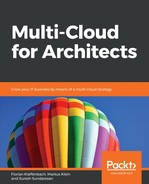Now let's take a look at a real-world scenario that involves designing a multi-cloud architecture for a mid-size European company with locations in the United States, Japan, and Moscow, in addition to their worldwide headquarters in Munich. They are working in the medical and health care area and decided to completely move every IT service to the cloud, except their data center in Moscow, as their IT team is located there. But even for this location, their goal is to minimize the on-premises servers and even work in the data center environment using public cloud technology, as this would give them the chance to move the last on-premise servers to a public cloud, if somehow, in the future, their data center needs to move.
As of today, the company is running the following services:
- Active Directory on Windows Server 2012 R2 with four domain controllers' in the IT headquarters in Moscow.
- Each location has two domain controllers' on-premises.
- 480 member servers, running Windows Server 2008 and higher.
- 280 Ubuntu 17 servers.
- VMware, as a virtualization layer.
- Each server is a virtual machine; even their firewalls (checkpoint) are virtual machines.
- The company's network is MPLS-based, operated by AT&T. They have a central internet breakout in Moscow.
- There are about 500 SQL server instances running on Windows and Linux. Each of them is already in the most recent release.
- About 50 servers are running custom installations developed by the company's development team. They are using Visual Studio for managing their code.
- About 4200 client devices are being used. Each of them is running Windows 7 and Office 2010. For mobile devices, they are using Apple iPhones.
- The central solution for business services is SAP, which is currently hosted in their local data center in Germany, and in Moscow as a redundant hot standby environment.
- They are currently managing their environment by using system center 2012 R2 tools.
- Their ITSM solution is already running as a SaaS solution in the ServiceNow cloud. This is the only solution that will survive the redesign and even in 2021 and later will run in the ServiceNow cloud.
The CEO has decided to have a cloud-first strategy, and all of the cloud migration must be done by the end of 2021, as all the existing data center contracts would be cancelled by then. In addition, they have already decided to implement a two cloud vendor strategy using Microsoft Azure and Amazon Web Services. AWS should mainly be used by their development team, as the chief of development is a former employee of AWS. The head of IT has decided to move all of the infrastructure services mainly to Microsoft Azure.
Suppose that you are the responsible, external consultant, helping to design the new IT environment.
